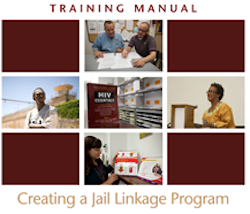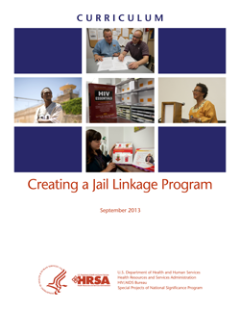Training materials and a curriculum on implementing a project to enhance HIV health services between community and jail settings, based on insights from the SPNS initiative, Enhancing Linkages to HIV Primary Care & Services in Jail Settings Initiative.
Training Manual

This training manual synthesizes lessons learned from the federally funded, innovative Special Projects of National Significance Enhancing Linkages to HIV Primary Care & Services in Jail Settings Initiative, otherwise known as EnhanceLink. Approximately 85 percent of incarcerated persons in the United States pass solely through jails, yet most interventions focus exclusively on prisons. EnhanceLink thus fills an important research void.
Curriculum

This curriculum is meant to inform implementation of a new jail linkage program and to assist organizations in expanding their current jail work. Target audiences include AIDS service organizations, community-based organizations, Ryan White HIV/ AIDS Program grantees and providers, and local health departments.
The guide offers programmatic steps and planning questions as well as useful templates to get started on jail linkage work.
Implementation Guide
Expanding Jail Services & Improving Health for Incarcerated People with HIV: Intervention Implementation Guide reviews the Maricopa County Jail Project, which was implemented by five jails and uses a nurse practitioner to manage service access and case management across the jail system.
Handbook
This handbook details New York City Correctional Health Services’ Transitional Care Coordination intervention model, including program planning, implementation steps, and lessons learned. New York City was a SPNS grantee funded under the larger EnhanceLink study.
Pocket Guides
This guide is intended for organizations, agencies, and individuals considering strengthening connections between community and jail health care systems to improve continuity of care for recently incarcerated HIV-positive individuals. This guide is meant to provide approaches to implement new jail linkage programs or to help organizations and agencies plan how they can expand their current jail work. The target audience includes health care institutions, agencies, individual clinicians, and community partners with an interest and need to work with incarcerated populations, particularly HIV-positive jail inmates and the recently released.
Case Studies
These case studies highlight evidence-informed interventions focused on linkage to care. The case studies include: Intervention steps at-a-glance to provide an overview of featured activities, resource checklists outlining necessary capacity for replication, staffing table with personnel overviews, and narrative sections to walk readers through processes for replication.
